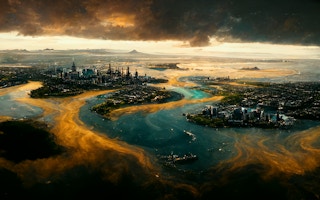It’s the turn of the next century, and downtown Auckland is half-smothered by the rising seas. Sooty buildings are spewing neon-orange sewage into the Pacific ocean, creating enclaves divided by cesspools.
To continue reading, subscribe to Eco‑Business.
There's something for everyone. We offer a range of subscription plans.
- Access our stories and receive our Insights Weekly newsletter with the free EB Member plan.
- Unlock unlimited access to our content and archive with EB Circle.
- Publish your content with EB Premium.
This is the future awaiting the city known for its beautiful environment, as envisaged by an image generator software, Midjourney, that has been fed keywords such as “photorealism”, “futuristic” and “cinematic”.
USwitch, a UK-based price comparison website, used Midjourney to demonstrate versions of iconic cities in 2100 such as Los Angeles (surrounded by wildfires), Tokyo (covered in smog) and Rio de Janeiro (pounded by heavy rain). The visuals are far removed from being a scientific projection as many look like oil paintings and some feature alien-looking birds.
But USwitch says the project, launched last month, helps people visualise the future if climate change is not taken seriously today. It referenced the latest United Nations climate change report on future impacts, and also generated a set of images showing idyllic scenarios if the world manages to halt carbon emissions in the coming decades.
The firm also worked with a climate expert at Oxford University to explore 2050 net-zero emissions pathways.
“The project was created with COP27 in mind; this is a time when world leaders can come together and set out clear objectives and agreements on how they will tackle the climate emergency head-on,” said a USwitch spokesperson. In a press release, the firm also encouraged people to travel less by car, reassess their diets and make their homes more energy efficient.
Here are more pictures that Midjourney has generated of major cities in the Asia Pacific , based on USwitch’s keywords. Drag the white handlebar in the middle of each image to take a peek at the dystopian versus utopian scenarios.
1. Agra, India
India currently ranks third in carbon emissions by country, but Prime Minister Narendra Modi has made a series of pledges, including using renewable energy resources to meet 50 per cent of India’s energy needs by 2030.
The world’s second most populous country is expected to face mounting climate risks in the coming decades. Earlier this year, a heatwave that saw temperatures climb as high as 45°C swept across the country. The episode was immediately followed by flooding that killed hundreds.
2. Beijing, China
The capital of China is notorious for air pollution as a result of its past three decades of industrial boom. In 2013, the high concentration of toxic smog even sparked protests. The smog and sandstorms blowing in from the country’s western deserts have also been known to turn the sky above the city orange.
Beijing has made substantial progress after cracking down on coal emissions and was reported at the beginning of this year to have met all its air quality targets.
3. Dubai, United Arab Emirates
Dubai is the most populous city in the United Arab Emirates (UAE) and is also one of the most popular tourist sites in the world. It suffers from pollution from its factories and vehicle emissions.
The UAE is heavily reliant on fossil fuels but it has a plan to reach net-zero emissions by 2050, through initiatives in clean energy production and green mobility.
4. Sydney, Australia
In the past two decades, Sydey’s rapid bursts of rain have become at least 40 per cent more intense. The sunny state was ravaged by numerous storms this year and residents were told to expect a prolonged cold spell despite having entered the summer season. Under its previous, long-running conservative leadership, efforts to prevent climate change were slow.
Its new government has enshrined emission reductions targets into law, and the country also has a 2050 net-zero target.
5. Tokyo, Japan
Like many other large cities, the worst and most widespread air pollution faced by Tokyo is that of airborne PM2.5 particles. The Japanese capital’s average levels are just above the WHO’s guideline of 12mg/m3. Between 2010 to 2019, deaths attributed to air pollution in Japan increased continuously, making it the eighth leading cause of death in the country.
Japan’s greenhouse gas emissions in 2020 were the lowest since 1990. Although Covid-19 played a part, its government also altered the country’s emissions targets to reach a more aggressive 46 per cent reduction by 2030 and net zero by 2050, compared to the previous goals of 26 per cent by 2030 and 80 per cent by 2050.










